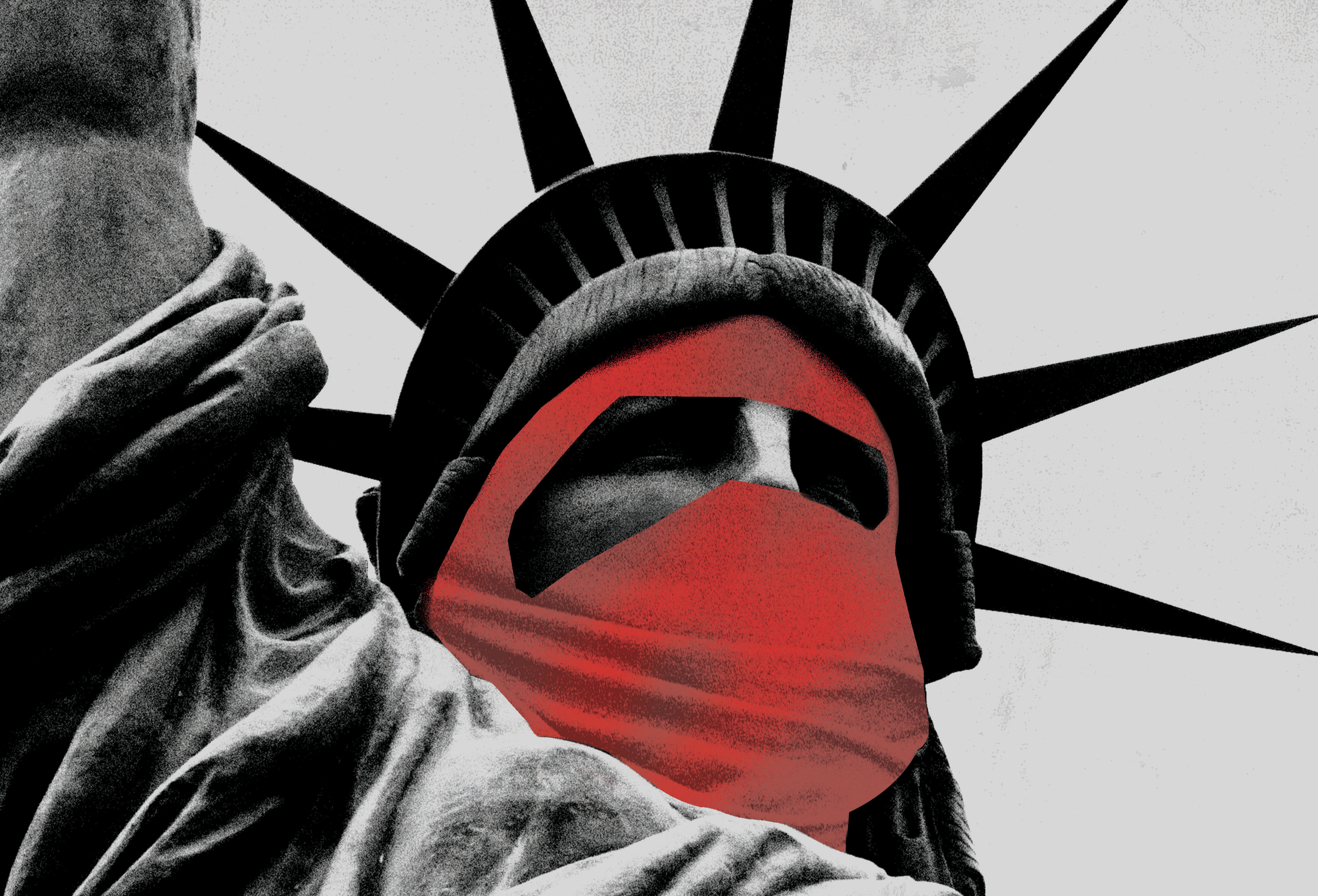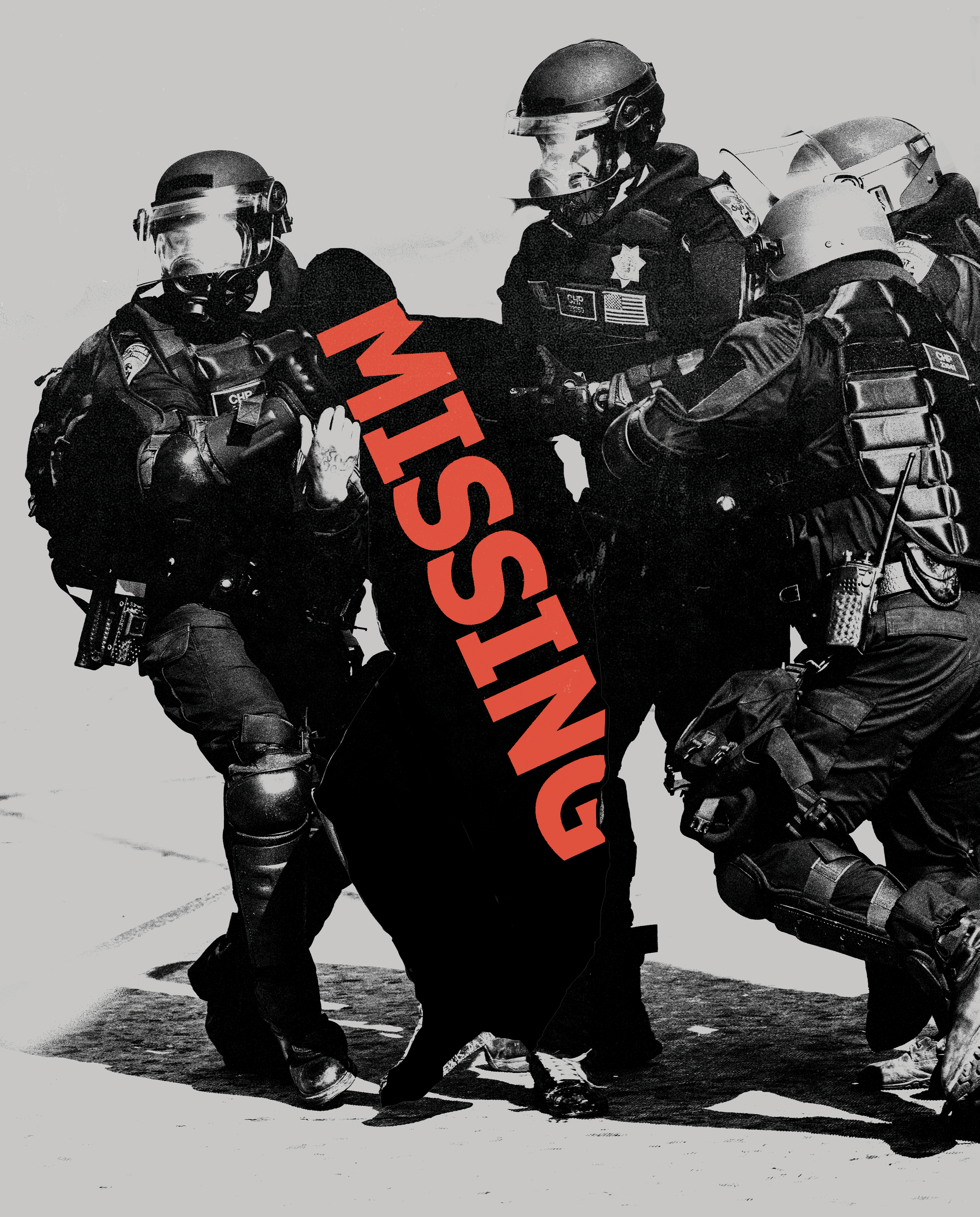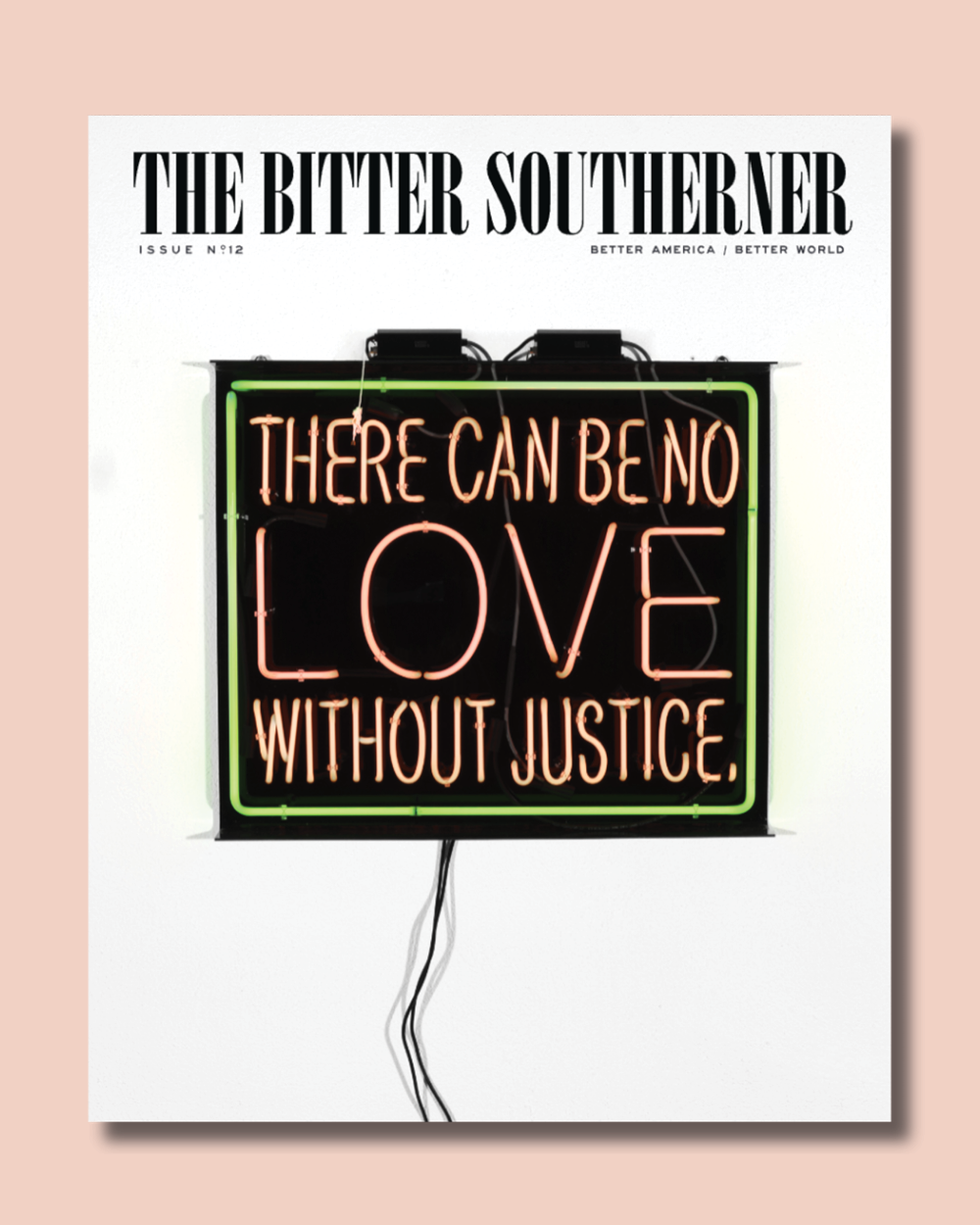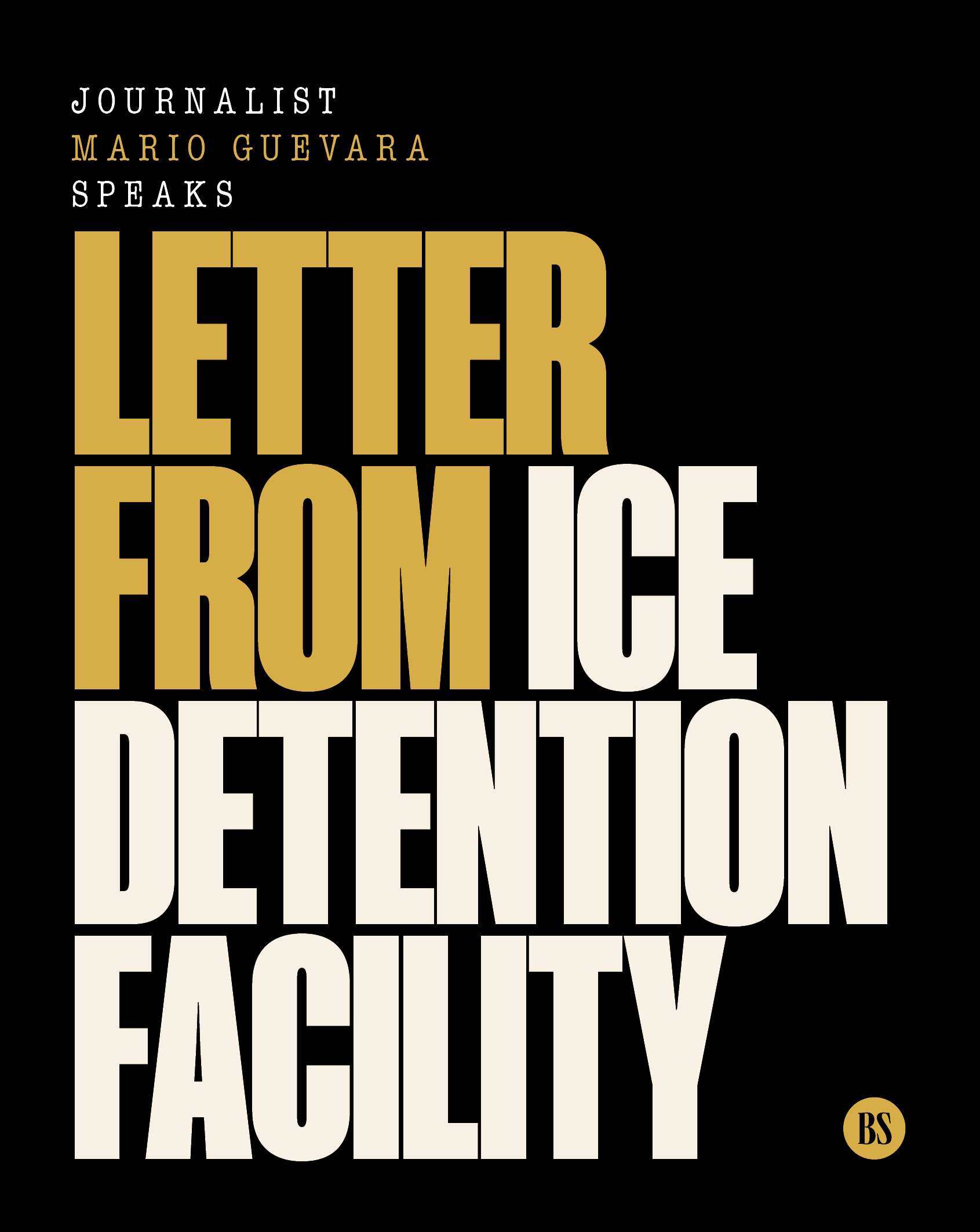Words by Charles M. Blow
Illustrations by Mark Harris
October 8, 2025
n July 1, as Donald Trump marched to Marine One on his way to visit the hastily constructed Everglades immigrant detention center that Republicans were marketing — at turns blithely, at others with a glint of malice — as “Alligator Alcatraz,” he stopped briefly to engage a gaggle of reporters, announcing his excitement about the new facility.
One reporter asked, “Is the idea that if some illegal immigrants escape, they just get eaten by an alligator or a snake or something?”
Trump’s rigid pout gave way to a Grinchy smile, “I guess that’s the concept.”
“We’re going to teach them how to run away from an alligator, OK, if they escape prison, how to run away. Don’t run in a straight line, run like this,” he said, oscillating his hand in the air the way reptiles move through water.
There was a pitiless glee in Trump as he imagined this survival game, humans desperately fleeing rows of ripping teeth.
Even the name “Alligator Alcatraz” is grotesque and speaks to a sadistic jocularity, a salivating delight, suffering for mass consumption. Though, at press time, the South Florida facility’s future was in jeopardy because of its environmental impact, similar proposals in other locations include “Deportation Depot,” “Cornhusker Clink,” and “Speedway Slammer.” It is a Disneyfication of horror.
And, Republicans have embraced that view of it. The Department of Homeland Security posted an AI-generated image of alligators in ICE hats prowling a prison fence. Smiling tourists have posed for selfies in front of the detention center’s sign. The National Republican Congressional Committee sold T-shirts featuring a lounging cartoon alligator and the phrase “ICE with a bite.”
Each tent at the Everglades facility contained eight cages. Each cage contained 32 detainees who shared just three prison toilets with integrated sinks. Institutional lighting glared without reprieve. At peak capacity, detainees complained of hunger, unsanitary conditions, and swarming mosquitos.
This is not unlike the conditions in other immigrant detention centers. As The New York Times reported in July about the nation’s immigration detention system “buckling under the weight of record numbers” due to overcrowding:
Some immigrants have gone a week or more without showers. Others sleep pressed tightly together on bare floors. Medications for diabetes, high blood pressure and other chronic health problems are often going unprovided. In New York and Los Angeles, people have been held for days in cramped rooms designed for brief processing, not prolonged confinement, and their lawyers and family members have remained in the dark about their whereabouts.
But, by making “Alligator Alcatraz” both potent symbol and a farcical abstraction, the cruelty feels light and casual, childish even. The branding attempts to reconcile contradictions: The policy vicious, but righteous; harsh, but cheerful. Americans are being led, willingly, applaudingly, into the crime of complicity, a callous ruthlessness, an implacable lust for punishment that portends — or demonstrates — the dying of the nation’s soul.
The moment is eerily reminiscent of the Jim Crow era, when families picnicked in the shadow of lynchings and purchased commemorative postcards featuring the gruesome deeds. We have not returned to that depth of violence, to be sure. What we have now is less severe, but today’s ruthlessness stokes more widespread hostility than any hangman could have dreamed.
As of late September, there were nearly 60,000 people in ICE detention, and Stephen Miller, the White House deputy chief of staff and Machiavellian architect of the administration’s immigration policy, has pressured ICE to reach 3,000 arrests per day, at minimum, a staggering and unprecedented number.
There is a deliberate conspicuousness to ICE’s inhumanity. Cruelty is being performed. It is pageantry, and intentionally so. Terror craves notoriety. Indeed, it depends upon it. It must ripple. It must be vicariously experienced. That is the amplification dependency of it.
It is masked men descending on the unsuspecting, prowling public parks on horseback, storming children’s birthday parties, skulking about in courthouse corridors. It is spiriting people away to far-flung detention facilities, deportations to third countries and even third continents where some have reported being tortured. It is stoking the terror of vanishing, of family separations, of disappeared parents and orphaned children.
The message is ominous and chilling: You’re not welcome, you’re not safe, you’re being hunted, you will be consumed by the beast.
This showy terror is being deployed as deterrent and spur: scaring immigrants from entering the country and scaring those already here to self deport. Reducing illegal immigration is a legitimate policy goal; forfeiting our humanity — and robbing others of theirs — to achieve it is not.
This manufactured terror is having the effect, possibly desired, of pushing many immigrants into seclusion, some even afraid to seek medical care. Immigrants who are in the country legally, and even some American citizens, have been caught in ICE’s dragnet. Imagine how this might keep them away from the polls during the next election cycle.
“Alligator Alcatraz” is part of this architecture of fear. Florida Democratic Congressman Maxwell Frost, who visited the Everglades facility in July, told me that he considers the ICE facilities “internment camps” for two reasons: “Number one, that’s what it is … [Immigrants] are essentially political prisoners, they are there as a result of a political campaign.” Secondly, Frost says, is “the ethnic makeup of them, which is really similar to the Japanese internment.” Indeed, as this issue was going to press, the Trump administration had begun holding immigrants at Fort Bliss in El Paso, Texas, which was used during World War II as an internment camp for Japanese Americans. It is scheduled to become the largest detention site in the country.
Border Czar Tom Homan confirmed ICE’s racial profiling in July, saying that “physical appearance” was one of the factors that its officers and border patrol could use to “walk up to somebody, briefly detain ’em and question ’em” without probable cause. And in September, the Supreme Court upheld just that, overturning lower federal court rulings and allowing ICE to continue its racial profiling as court challenges proceed.
The country has experimented before, and relatively recently, with surging law enforcement to deal with a so-called “crisis” blamed on a particular racial/ethnic group.
The 1994 crime bill, then the largest bill of its kind, was designed to help local law enforcement hire 100,000 new officers, and billions went to new prison construction in states with “truth in sentencing” laws that, for many, took away the option of early parole.
Mass incarceration would soon peak, but the law dramatically expanded the machine without building in levers for contractions as crime fell. Some police departments simply set their sights on lower-level crimes. In New York City, for instance, after crime plummeted, the city adopted an aggressive — and ultimately determined unconstitutional — application of stop-and-frisk policies in which the vast majority of people stopped were Black or brown boys and men.
The federal judge who struck it down quoted from one of my columns in the penultimate lines of her 2013 decision:
The idea of universal suspicion without individual evidence is what Americans find abhorrent and what black men in America must constantly fight. It is pervasive in policing policies — like stop-and-frisk, and . . . neighborhood watch — regardless of the collateral damage done to the majority of innocents. It’s like burning down a house to rid it of mice.
Now, the administration seems determined to repeat this very mistake, allocating $165 billion to the DHS, growing it quickly, with no provision for ever snapping it back to a smaller size.
The new funding calls for hiring 10,000 additional ICE agents, 3,000 more customs officers, and 3,000 new Border Patrol agents. It also provides for building more detention centers, which, according to DHS, “provides ICE with enough detention capacity to maintain an average daily population of 100,000 illegal aliens and secures 80,000 new ICE beds.” Last year, Congress allocated only 41,500 beds for the agency.
As journalist and author Garrett Graff pointed out in July on his website, Doomsday Scenario:
What happens when a law enforcement agency at any level grows too rapidly is well-documented: Hiring standards fall, training is cut short, field training officers end up being too inexperienced to do the right training, and supervisors are too green to know how to enforce policies and procedures well.
Graff underscores that, “anyone familiar with policing can rattle off the police hiring surges that inevitably led to spikes in corruption.”
In June, Jelani Cobb, dean of the Columbia Journalism School, drew a comparison between 19th-century Americans who opposed the Fugitive Slave Act and those who now oppose ICE’s aggressive policies, explaining on MSNBC that not everyone who objected to the Fugitive Slave Act was an abolitionist. To the contrary, “these were people who could not countenance the idea of their neighbors being taken from them,” Cobb said. He continued:
The fundamental civic unit in this nation is “neighbor.” And, that is the people who live in your community. Are you prepared to see them treated in this way? And, people simply were not.
Indeed, as Joshua Zeitz, author of Lincoln’s God: How Faith Transformed a President and a Nation, wrote in Politico in July, the 1850 act — which was far more extreme than earlier laws governing runaway enslaved people — so radicalized the North that “seemingly overnight, white people who previously cared little for the plight of Black Americans, free or enslaved, became committed antislavery voters.” They supported runaways in various ways, in defiance of the government. Zeitz wrote, “A vocal but committed core came to believe that the only means to confront state violence and coercion was to meet that threat with violence in turn.”
Northern opposition to slavery did not coalesce quickly. There had been a “Fugitive Slave Clause” in the Constitution, ratified in 1788. Congress had passed, and President George Washington signed, the Fugitive Slave Act of 1793, over Northern objections. And, a revised and strengthened Fugitive Slave Act was passed and signed in 1850.
When Abraham Lincoln delivered his first inaugural address in 1861, straining to appease antsy Southern secessionists, he proclaimed that he was duty bound to enforce the Act. For this, Frederick Douglass would excoriate him as an “excellent slave hound.”
Opposition to fugitive slave laws simmered and swelled for decades, as the laws became more severe, before that agitation contributed to the commencing of the Civil War, which began just a month after Lincoln’s inauguration.
Modern America doesn’t have that much time or patience. A decades-long horizon is unfathomable to us in this high-paced, digitally dynamic, attention-shriveling era. Modern resistance demands massive pressure and relatively swift action.
As American University sociology professor Dana R. Fisher wrote in her 2019 book, American Resistance: From the Women’s March to the Blue Wave, because Trump’s first election created “a countermovement with a common enemy” it was possible to “bring diverse streams of progressive activism together even though they have historically competed for resources, energy, and attention.”
Momentum peaked with the massive 2020 summer of protest following the killing of George Floyd, but its power began to wane as Black Lives Matter declined, a conservative backlash cropped up, and the public’s interest in the issue of race abated.
There was a new burst of activism around the war in Gaza, but those protests put more strain on the existing coalition, particularly in the final months of the 2024 presidential campaign, as many Jewish, Muslim, Black, young progressives, and establishment Democrats came to have conflicting views.
While Trump’s first election quickly coalesced the opposition, his reelection has been a depressing, bunker-busting event, fracturing traditional alliances over feelings of betrayal, and it is only slowly recovering. Still, polls show a growing distaste for Trump’s deportation policies, and some communities are organizing to protect their immigrant neighbors.
Peter H. Wood, a history professor at the University of Colorado Boulder, says that what he finds striking is the “longevity” and “gestational period” of America’s appetite and tolerance for the forcible control of bodies — then Black, now brown — and “a lot of the things we’re seeing now resonate with that [pre-Civil War period.]”
Out of this period came the slave patrol, official local law enforcement, and slave catchers, bounty hunters often prowling the streets of cities in non-slave states or monitoring known routes to freedom.
The lust for control didn’t end with slavery. In a way, it was amplified. As Wood put it, during Reconstruction the Ku Klux Klan picked up on the tradition of slave patrols and night riders, “but they intensified it partly because they had lost control, you know, that the country had become woke.”
That battle against liberalism and multi-racialism, a form of wokeness, keeps resurfacing and has now done so again in the Trump era.
Some see Trump’s ICE push as evidence of a rising fascism. As Illinois congresswoman Delia Ramirez, the daughter of Guatemalan immigrants and married to a DACA recipient, told Democracy Now in response to Trump’s threats to deploy troops in cities across the country to quash anti-ICE protest: “What you are seeing is the beginning of fascism, point blank.”
Ramirez continued: “For fascists, they select a public enemy. And today, it’s an immigrant. Tomorrow, literally tomorrow, it’s anyone they find undesirable.”
But, it is important to remember that fascism is not new to America. What is new is a broadening application, a widening of the aperture.
As Langston Hughes said while speaking in Paris about the Spanish Civil War at the Second International Writers Congress in 1937: “We Negroes in America do not have to be told what fascism is in action. We know. Its theories of Nordic supremacy and economic suppression have long been realities to us.”
While Trump’s authoritarianism may be a parody of the world’s dictators, his immigration tactics are vintage Americana, the revival of a distinct antebellum terror aesthetic.
They are domestic heritage.
The American record demonstrates that if you can convince the public that your targets are monsters, subhuman, and predacious, you can convince them to respond with unchecked barbarity.
Fugitive slaves allegedly suffered from a peculiar form of insanity called drapetomania, a pseudoscientific absurdity that helped justify the 1850 Fugitive Slave Act. Freedmen became kindling for a Black brute rape hysteria which fueled an epidemic of lynchings. Those same men were portrayed as prone to all manner of criminal savagery, helping to justify the establishment of Jim Crow.
More recently, Black boys and men being viewed as congenitally defective, criminal, and unfeeling, branded with the now-discredited “crack babies” epithet, helped supercharge the drug war and mass incarceration of the 1994 crime bill.
Railing against the hellscapes of inner cities where “you get shot walking to the store,” and people have “no education” and “no jobs,” helped propel Donald Trump to his first term. Doubling down on immigrants as not only criminals but also coming from insane asylums — even eating people’s pets — helped secure his second term and set the tone for this immigration regime.
In a viral clip from a 2017 dinner between author and chef Eddie Huang and white nationalist Jared Taylor, the latter says, “I voted for Donald Trump for one reason only: His policies, if implemented, would slow the dispossession of whites in the United States.”
Taylor is the founder of New Century Foundation, which hosts American Renaissance magazine and website. The Southern Poverty Law Center has labelled American Renaissance a hate group.
In “a word of introduction to our readers” published as the opening essay in its inaugural issue, the magazine wrote:
In fact, blacks and Hispanics are, compared to whites, far more likely to be poor, illiterate, on welfare, or in jail; they are far more likely to have illegitimate children, be addicted to drugs, or have AIDS. By no definition of international competitiveness can the presence of these populations be anything but a disadvantage.
A dead-eyed Miller reinforced this idea last April, saying on Fox News, “If you import the third world, you become the third world, simple as that.”
This anti-immigration sentiment is all triggered by the fear of domination and dispossession. It’s about the fear of white replacement.
A 2022 UMass Amherst Poll found that two-thirds of Republicans endorse some form of the tenets of the “Great Replacement” theory, which espouses that the growth in the number of immigrants in the U.S. means the country is in danger of losing its culture and identity, and 4 in 10 Republicans believe immigrants are “poisoning the blood of the nation,” that “many are terrorists” or they “want to rape, pillage, thieve, plunder and kill American citizens.”
Miller has long held these views. The Southern Poverty Law Center’s Hatewatch obtained a 2015 email from Miller to far-right outlet Breitbart News in which Miller cited Jean Raspail’s disturbing 1973 novel The Camp of the Saints, published in France, that imagines a dystopian future in which the white West is overrun by immigrants from developing countries.
In one passage, Raspail writes:
All the kinky-haired, swarthy-skinned, long-despised phantoms; all the teeming ants toiling for the white man’s comfort; all the swill men and sweepers, the troglodytes, the stinking drudges, the swivel-hipped menials, the womanless wretches, the lung-spewing hackers; all the numberless, nameless, tortured, tormented, indispensable mass. . . . They don’t say much. But they know their strength, and they’ll never forget it. If they have an objection, they simply growl, and it soon becomes clear that their growls run the show. After all, five billion growling human beings, rising over the length and breadth of the earth, can make a lot of noise!
When The Atlantic wrote about the book in 1994, in a piece analyzing the world’s shifting demographics and the relative decline of Europe’s and North America’s dominance, the headline noted, “Absent major changes in North-South relations, the wretched should inherit the earth by about 2025.”
It’s 2025.
While the conspiracy theory that this replacement is being orchestrated by mysterious liberal elites is xenophobic hysteria, the mathematical fact that the nonwhite population is outpacing the white one in this country is irrefutable.
Trump, therefore, has become the right’s bulwark against the adage, “demography is destiny.” White Dominionists have no plans to accept the night quietly, and they never have. They continue to be animated by domination anxiety.
What’s more, they are foisting their anxiety about an evolving world onto the shoulders of those who represent that change. In this way, we should see Trump’s immigration policy not as the manufacturing of terror, but as the transference of it. It is the undergirding of an enduring national ethos: white people deserve protection and reassurance; it is the “others” who should be afraid. That is, depressingly, America’s racial fantasy.
We have, in many ways, conscious and not, assigned the undocumented to the lowest caste in this country: they are America’s Dalits, in the shadows, performing labor many citizens wouldn’t deign to do. And, in that light, a monstrous unwritten truth emerges — they’re not afforded the same, basic human dignity as others; they are locked out of access to our full empathy.
Part of this is our Black-and-brown blind spot, how we report of racial and ethnic people in this country (or from developing countries) in macro, desensitized ways — the numbers of people dead, injured, or harmed — rather than from the micro, humanity-focused ways — including the stories of individuals, named and acknowledged, their tears streaming, their anguish palpable.
Research has shown that while people can show compassion toward a single person in distress, that compassion does not grow as the number of victims grows. Compassion actually contracts.
Paul Slovic, psychology professor at the University of Oregon, has done groundbreaking research on the matter and puts it this way: “Statistics are human beings with tears dried off” — a line he used in a 2007 paper about psychic numbing and genocide. Slovic sees this as particularly dangerous because our tears, as a manifestation of our empathy, are our motivation.
But, as Slovic told me: “the opposite of numbing is something we call the ‘singularity effect,’ which is the strong reaction we have to individuals who are in distress.”
When we consider the current mass deportation scheme, how many of us can name a single detainee, an individual in distress, one who has made the news — and sustained its focus — not for the fleeting images of their captures, but for the enduring resonance of their narrative, of their life and humanity?
This is in part on purpose.
It is important for those being abducted to be hidden and spirited away because the greatest danger to a regime is a person who embodies the crisis — a face with eyes, staring and real, refusing to be reduced, ignored, and forgotten.
Today’s resistance needs a symbol like the enslaved African called Whipped Peter, the photograph of his body covered in keloids like a tangle of thorns. Like Emmett Till, a teen beaten and shot, his grotesquely distorted body fished out of the Tallahatchie River.
Like Rosa Parks, be-spectacled and stoic, a proper Southern Black woman who wore her long hair put up in braids and buns. Like Harvey Milk, a dynamic gay activist and politician who was assassinated by a colleague in the San Francisco City Hall. Like George Floyd gasping for breath under the knee of a Minneapolis police officer as he squeezed out a cry to “Mama.”
In an America barraged and buffeted by an unending series of assaults from this administration, oppression needs embodiment. The greatest defense against the dehumanization of a people is humanizing them. We need to say the names of those who are deported, disappeared, and mistreated. We need to insist on those names being heard and known, condensing sympathies with a piercing clarity. ◊
Charles M. Blow is a journalist, author, and political analyst. He is currently the inaugural Langston Hughes Fellow at Harvard University.
Mark Harris is an award-winning graphic designer whose work has been featured in The New York Times, The Atlantic, and many other publications.












